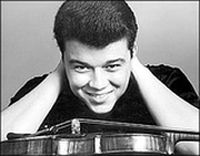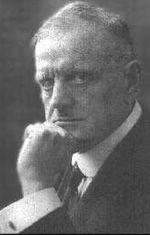
Date 23 and 25 April 2005 at 20.00 Venue The Orpheum Theatre
Tubin
Prélude solennel Tchaikovsky Violin
Concerto in D Major Sibelius Andante Festivo
and Symphony No. 5 in E-flat major
Conductor Eri Klas Violinist Vadim Gluzman
 |
|
Vadim Gluzman |
Aside from Tchaikovsky's Violin Concerto, this concert in the Vancouver Symphony's "Great Classics" series opted to spotlight somewhat less often performed work. Guest conductor Eri Klas offered illuminating readings of both the tried and true and the unfamiliar.
One wouldn't nonetheless want to hear Estonian composer Eduard Tubin's Prélude solennel (1940) very often in a lifetime, however well or intelligently played. Bordering on made-for-the-movies music, the piece rather than being "solemn" came off as pretentious, the kind of paint-by-numbers muzak composed for Laurence Olivier's Shakespeare films of the 1940s or for Star Wars. With a bits of Bolero tossed in and heavy gestures all round, trumpets, drums, and the whole brass section were worked over hard to convey this music on steroids, but some of the adrenalin-revving effects came off rather on the cheap side.
Tchaikovsky's Violin Concerto, played on the 1690 Stradivarius used at the première, came not a moment too soon to save one from musical bathos, and what a red-blooded and dazzlingly confident performance Vadim Gluzman offered, beginning somewhat more slowly than usual with an almost aloof approach, then becoming committed and passionate, and closing with simply breathtaking prestissimo playing that held the audience spellbound.
w
w
w
.
r
e
v
i
e
w
V
a
n
c
o
u
v
e
r
.
o
r
g
Maestro Klas brought out both the second movement's soulful, Slavic character as well as the flashier and vivid big moments of the Allegro vivacissimo finale. The first movement's cadenza was richly textured, with Gluzman caressing out torrents of golden-honey sound from a wonderful, even magical, instrument.
 |
|
Jan
Sibelius |
Sibelius's short Andante Festivo (1922) for strings and tympani, the appetizer to the main work of the programme's second part, got a tightly disciplined, focussed reading. The powerful and sweeping effects lead to a noble conclusion. One suspects, however, that the Finnish approach to festivity features a good dollop of restraint and even some tight-lipped solemnity, the tempo marking confessing to a national temperament.
Sibelius's majestic three-movement Symphony No. 5 in E-flat major , written in 1915 and revised four years later, builds tensions and withholds relief almost to the point of the unbearable in the first molto moderato movement, a study in Modernist anxiety until its surprisingly confident close. The chirpy impulses and dance-like character of the second quasi allegretto movement come as a surprise, with rosy-cheeked gentility and self-assurance at the fore. The closing Allegro molto has a perpetuum mobile character, convincingly contrasted with a more contemplative strain, but energy is the keynote here and Maestro Klas never stinted, drawing out from an already hard worked orchestra yet one more leap and yet one more sprint to close a successful and satisfying evening of music-making.
© 2005 J. H. Stape